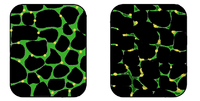
Interaction between mesenchymal stem cells and myoblasts in the context of facioscapulohumeral muscular dystrophy contributes to the disease phenotype
Sign Up to like & getrecommendations! Published in 2022 at "Journal of Cellular Physiology"
DOI: 10.1002/jcp.30789
Abstract: Facioscapulohumeral muscular dystrophy (FSHD) is a genetic disease associated with ectopic expression of the DUX4 gene in skeletal muscle. Muscle degeneration in FSHD is accompanied by muscle tissue replacement with fat and connective tissue. Expression… read more here.
Keywords: interaction; facioscapulohumeral muscular; cxcr4; muscular dystrophy ... See more keywords

A case of type 1 facioscapulohumeral muscular dystrophy (FSHD) with restrictive ventilatory defect and congestive heart failure
Sign Up to like & getrecommendations! Published in 2020 at "eNeurologicalSci"
DOI: 10.1016/j.ensci.2020.100284
Abstract: [Background] Facioscapulohumeral muscular dystrophy (FSHD) is an autosomal dominant muscle disease characterized by asymmetric involvement of muscles in the face, upper extremity, trunk, and lower extremity regions, with variable severity. It was recently reported that… read more here.
Keywords: dystrophy fshd; muscular dystrophy; facioscapulohumeral muscular; restrictive ventilatory ... See more keywords

Respiratory function in facioscapulohumeral muscular dystrophy 1
Sign Up to like & getrecommendations! Published in 2017 at "Neuromuscular Disorders"
DOI: 10.1016/j.nmd.2017.03.008
Abstract: To test the hypothesis that wheelchair dependency and (kypho-)scoliosis are risk factors for developing respiratory insufficiency in facioscapulohumeral muscular dystrophy, we examined 81 patients with facioscapulohumeral muscular dystrophy 1 of varying degrees of severity ranging… read more here.
Keywords: facioscapulohumeral muscular; muscular dystrophy; respiratory function; kypho scoliosis ... See more keywords

Isokinetic assessment of trunk muscles in facioscapulohumeral muscular dystrophy type 1 patients
Sign Up to like & getrecommendations! Published in 2018 at "Neuromuscular Disorders"
DOI: 10.1016/j.nmd.2018.09.007
Abstract: Facioscapulohumeral muscular dystrophy type 1 is the third most common inherited myopathy. Its severity is proportionate to the loss of microsatellite D4Z4 repetitions, which are below 10. Patients suffer from weakness in facial muscles, shoulder… read more here.
Keywords: facioscapulohumeral muscular; muscular dystrophy; trunk; dystrophy type ... See more keywords

Human miRNA miR-675 inhibits DUX4 expression and may be exploited as a potential treatment for Facioscapulohumeral muscular dystrophy.
Sign Up to like & getrecommendations! Published in 2021 at "Nature communications"
DOI: 10.1038/s41467-021-27430-1
Abstract: Facioscapulohumeral muscular dystrophy (FSHD) is a potentially devastating myopathy caused by de-repression of the DUX4 gene in skeletal muscles. Effective therapies will likely involve DUX4 inhibition. RNA interference (RNAi) is one powerful approach to inhibit… read more here.
Keywords: muscular dystrophy; inhibits dux4; dux4 expression; mir 675 ... See more keywords

Nanopore-based single molecule sequencing of the D4Z4 array responsible for facioscapulohumeral muscular dystrophy
Sign Up to like & getrecommendations! Published in 2017 at "Scientific Reports"
DOI: 10.1038/s41598-017-13712-6
Abstract: Subtelomeric macrosatellite repeats are difficult to sequence using conventional sequencing methods owing to the high similarity among repeat units and high GC content. Sequencing these repetitive regions is challenging, even with recent improvements in sequencing… read more here.
Keywords: muscular dystrophy; facioscapulohumeral muscular; nanopore based; d4z4 array ... See more keywords

Ultrasound pattern of anterolateral leg muscles in facioscapulohumeral muscular dystrophy
Sign Up to like & getrecommendations! Published in 2021 at "Acta Neurologica Scandinavica"
DOI: 10.1111/ane.13428
Abstract: To evaluate the degree of tibialis anterior (TA) and peroneus longus (PL) muscle involvement in facioscapulohumeral muscular dystrophy (FSHD) patients using ultrasound. read more here.
Keywords: ultrasound pattern; muscular dystrophy; facioscapulohumeral muscular; anterolateral leg ... See more keywords

De novo variants and recombination at 4q35: Hints for preimplantation genetic testing in facioscapulohumeral muscular dystrophy
Sign Up to like & getrecommendations! Published in 2022 at "Clinical Genetics"
DOI: 10.1111/cge.14250
Abstract: Facioscapulohumeral muscular dystrophy (FSHD) has been associated with the deletion of an integral number of 3.3 kb units of the polymorphic D4Z4 repeat array at 4q35. The prenatal identification of this defect can be carried… read more here.
Keywords: preimplantation genetic; facioscapulohumeral muscular; recombination 4q35; genetic testing ... See more keywords

A cre-inducible DUX4 transgenic mouse model for investigating facioscapulohumeral muscular dystrophy
Sign Up to like & getrecommendations! Published in 2018 at "PLoS ONE"
DOI: 10.1371/journal.pone.0192657
Abstract: The Double homeobox 4 (DUX4) gene is an important regulator of early human development and its aberrant expression is causal for facioscapulohumeral muscular dystrophy (FSHD). The DUX4-full length (DUX4-fl) mRNA splice isoform encodes a transcriptional… read more here.
Keywords: dux4; muscular dystrophy; pathology; facioscapulohumeral muscular ... See more keywords

Baroreflex sensitivity in facioscapulohumeral muscular dystrophy
Sign Up to like & getrecommendations! Published in 2022 at "Physiological Reports"
DOI: 10.14814/phy2.15277
Abstract: Facioscapulohumeral muscular dystrophy (FSHD), a common form of muscular dystrophy, is caused by a genetic mutation that alters DUX4 gene expression. This mutation contributes to significant skeletal muscle loss. Although it is suggested that cardiac… read more here.
Keywords: facioscapulohumeral muscular; people fshd; fshd controls; muscular dystrophy ... See more keywords

Upper limb function and activity in people with facioscapulohumeral muscular dystrophy: a web-based survey
Sign Up to like & getrecommendations! Published in 2017 at "Disability and Rehabilitation"
DOI: 10.3109/09638288.2016.1140834
Abstract: Abstract Purpose To investigate the upper extremity (UE) at the level of impairments and related activity limitations and participation restrictions in people with facioscapulohumeral muscular dystrophy (FSHD). Methods The study was conducted using web-based questionnaires… read more here.
Keywords: web based; muscular dystrophy; facioscapulohumeral muscular; people facioscapulohumeral ... See more keywords